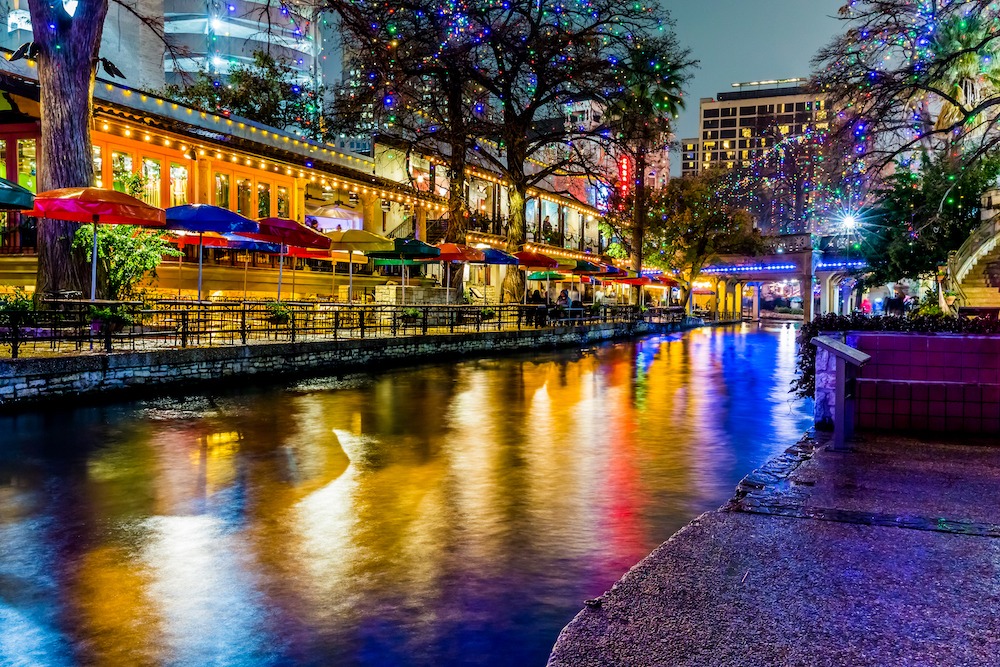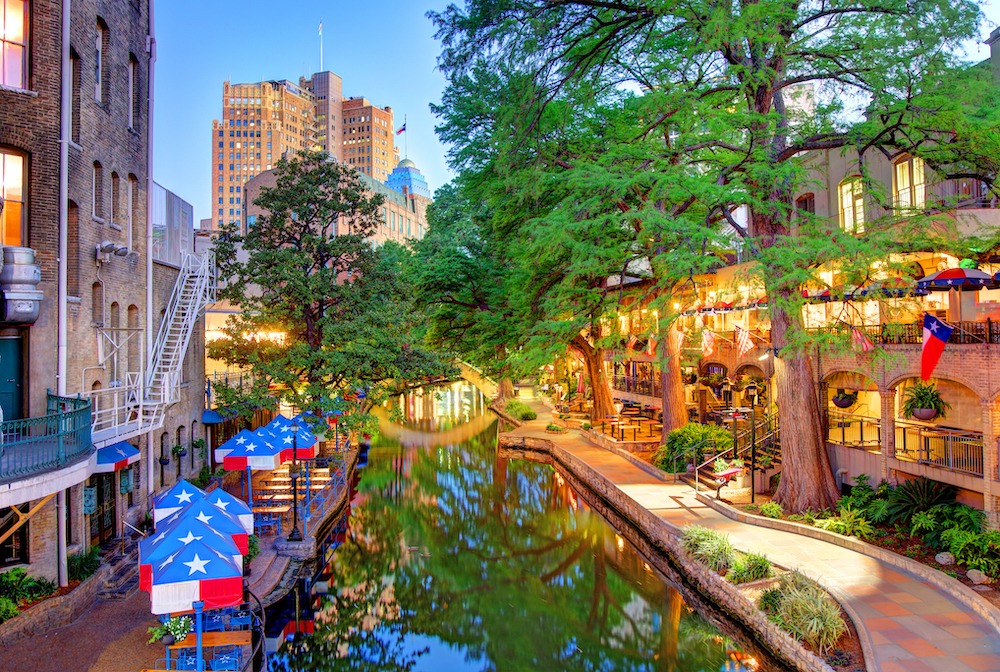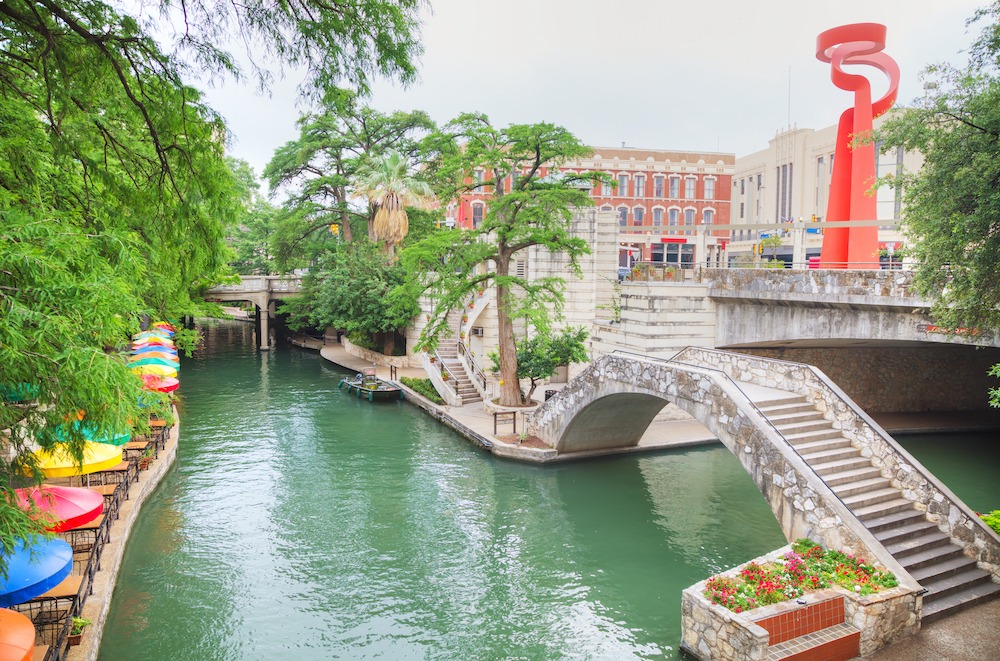Words: Macy Sears
Photos: AndreyKrav, DenisTangeyJr, Richard McMillin
The San Antonio Riverwalk lies within the heart of the city’s downtown center. Stretching over 15 miles, the area features scenic views, complete with dining and shopping options. As one of the leading tourist attractions in Texas, it draws in over 11.5 million visitors each year.
Today, ownership of the Riverwalk falls under the rights of San Antonio, Texas. The area undergoes continuous routine maintenance, including improvements and even expansions. The popular space is now home to a number of restaurants, shops, museums, and city-wide events.
Now, let’s take a step back and see how it all began.
Initial Plans and Development
In September 1921, the city of San Antonio experienced a devastating flood, killing over 50 people. The incident warranted operations for flood control, including the development of a bypass channel and the Olmos Dam. Final plans for the flood control system also involved draining the San Antonio river bend, and paving it with concrete, to serve as a storm sewer.
Area residents opposed the final portion of the plan, wanting to preserve the beloved San Antonio River within the community. The opposition led to the establishment of the San Antonio Conservation Society. The group is now recognized today for saving the city’s river back in 1926.
Apart from the storm sewer, San Antonio proceeded in its progress for a flood control and drainage system. Work began on the bypass channel in 1926, and the city completed the Olmos Dam in 1927. According to the San Antonio River Authority, the cost for building the Olmos Dam was $1.5 million. The dam has a total of six flood gates and keeps two open at all times. An actuator maintains control over each gate, which sits inside the dam’s gatehouse.
Plans surfaced for the San Antonio Riverwalk from an architect named Robert H. H. Hugman in 1929. He originally called the project ‘The Shops of Romula and Aragon’. The proposal included a variety of river improvements and solutions to aid in the rebuilding from the disastrous flood. His plan supported the bypass channel but also proposed for additional resources to prevent future floods.
Hugman’s concept for the San Antonio Riverwalk was reminiscent of Venice, Italy. He highlighted space for shops, residences, greenery, and even boat rides. It wasn’t until 10 years later that his plan received its approval and began to break ground.
Riverwalk Construction
Development started for the Riverwalk on October 25, 1939. Works Progress Administration (WPA) supported its funding, providing over $400 thousand towards the initial investment. The project was a significant undertaking, and many attributed its work to helping America overcome the Great Depression.
Hugman served as the initial project architect and its construction extended through 1941. Upon its completion, the San Antonio Riverwalk featured many walkways, stairways, and roughly 20 bridges. Additionally, the area showcased a variety of landscaping, including towering-tall cypress trees. The Riverwalk was even home to Hugman’s architect office.

Hugman’s development plan also included the famous arched stone bridge. Today, the feature still remains one of the most notable points across the San Antonio Riverwalk.
San Antonio soon faced another major flood in 1946, putting the system and project plans to the test. Fortunately, with the help of the Olmos Dam and bypass channel, very little damage occurred. Later that year, the Riverwalk went on to open its first area restaurant – Casa Rio.
Over the next decade, the Riverwalk’s further development and growth continued to steadily progress. Although it was beginning to gain attention amongst the public, many were still hesitant towards the area. It wouldn’t be until years later for the San Antonio Riverwalk to become a true success.
The Rise In Popularity
The 1960s was a pivotal period for the advancement of the Riverwalk. The city of San Antonio supported funding to bring in outside design experts from Disneyland. Plans were extensive, embracing vast landscaping improvements. The change in scenery led to the opening of the first riverfront hotel in 1962 – El Tropicano.
Over the years, expansions for the San Antonio Riverwalk continued to evolve. City and council members formed the Paseo del Rio Association to support future project improvements. Many new shops and restaurants began to open within the area. The Riverwalk also became a center for city-hosted festivals, a common occurrence that is still in place today.
The riverfront area also went on to become home to a number of hotels, including the Hyatt Regency Hotel. The famous hotel opened in 1981 and featured a walkway to connect pedestrians from the Alamo Plaza to the San Antonio Riverwalk. Recognized as the Paseo del Alamo, the area is a beautiful oasis, showcasing concrete waterfalls and decorative greenery. The walkway is still a current favorite amongst tourists and locals today.
Channel Improvements – San Antonio River Tunnel
Although the San Antonio Riverwalk was undergoing massive improvements, flood control and adequate drainage still remained a major concern within the area.
A large portion of the 1980s centered around river channel improvements to ensure safety and control over excess water. San Antonio River Authority and local engineers began exploring the concept of diverting water into two tunnels built beneath the downtown region. The project would significantly reduce the chance of flooding within the area. The design plan became known as the San Antonio River Tunnel and construction began in 1988.
According to the San Antonio River Authority, The Tunnel travels approximately 16,300 feet long with a depth of 140 feet. The diversion tunnel is complete with precast concrete segmented liners measuring 24 feet by 4 inches in diameter.
Built by the BRG Garver Company, the channel intake begins near Josephine Street and Highway 281. The inlet structure consists of a 120 foot-long intake ogee weir and a sloped apron structure that is 63 feet long. The collected water transitions into a vertical shaft, which leads into the inlet shaft. The tunnel inlet shaft is 24 feet by 4 inches in diameter, with an inverted siphon dropping 118 feet.
The tunnel outlet shaft sits near Lone Star Boulevard. Built by Martin K. Eby Company, it contains embedded piping for dewatering facilities, cantilever retaining walls, trash racks, and a grated roof. The outlet structure measures 230 feet across the front and 50 feet across the rear, totaling 94 feet from its front to back. Water transitions into the outlet shaft, measuring 35 feet in diameter.
The construction of The San Antonio River Tunnel cost roughly $111M and development finished in 1997.
Recent Updates And Expansion Plans
Throughout the early 2000s, San Antonio Riverwalk improvements continued. The area proceeded to see additional shops, restaurants, and hotels opening within the area. The next major project expansion began in 2009, following the opening of Museum Reach.

Project development plans featured an extension of the Riverwalk from Downtown to Mission Espada. Broken into three phases, the expansion stretched over several miles. Phase one of the project provided the public with a one-mile trail for bike and hike access. Phase two included expansion of the path from San Pedro Creek to Mission Road. In the final phase of the Mission Reach project, the Riverwalk extended from Mission Road to Mission Espada.
Today, the Mission Reach project spans over eight-miles. The charming pathway is popular amongst tourists and locals. It features an emphasis on ecological improvements, as well as a beautiful collection of artwork along the trail.
Riverwalk Maintenance
The San Antonio Riverwalk Operations Division oversees the area’s upkeep, river improvements, security, and overall operations.
The Riverwalk undergoes regular planned maintenance for tending to its upkeep. This also includes periodic draining to ensure the water remains clear. In 2010 and 2011, the draining of the San Antonio Riverwalk resulted in the removal of over nine tons of sediment. Another major cleaning occurred in 2020 and for the first time included its main channel. The cleaning and removal of debris and trash lasted for a total of four days.
Current Day Attractions
The San Antonio Riverwalk as it stands today stretches over 15 miles. It serves as one of the leading attractions in all of Texas. It is also considered to be one of the largest urban ecosystems.
The area is home to many city-hosted events and festivals. Fiesta occurs along the Riverwalk and is a tribute to the heroes of the Alamo and the Battle of San Jacinto. Locals also enjoy the annual canoe race. The scenic area is a hotspot for weddings. It also made an appearance in several movies, including Selena and Miss Congeniality.
The San Antonio Riverwalk serves as a stage for holiday celebrations. Every year on St. Patrick’s Day, the city dyes the river green in celebration of the occasion. On Halloween, the area showcases a ghoulish parade and all-day live music. For San Antonio’s Christmas celebration, the Riverwalk is lit up with over 1.8 million lights, a tradition dating back to 1974.
Visiting the beautiful San Antonio Riverwalk is free to the public and it remains open 24/7, 365 days of the year.
